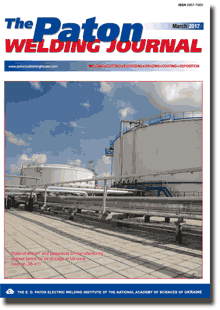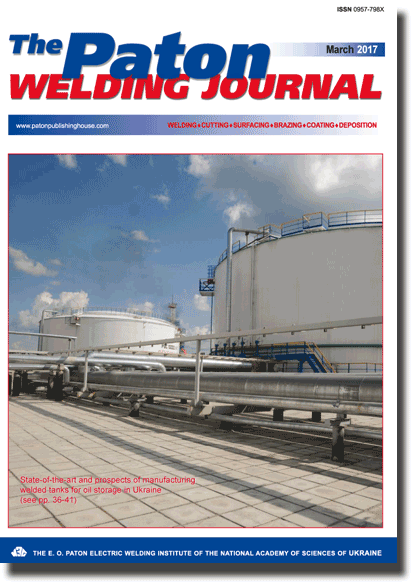
The Paton Welding Journal, 2017, #3, 15-24 pages
1E.O. Paton Electric Welding Institute, NASU 11 Kazimir Malevich Str., 03680, Kiev, Ukraine. E-mail: office@paton.kiev.ua
2Dneprosky State Technical University 2 Dneprostrojevskaya Str., 51918, Kamenskoe, Ukraine
Abstract
Detailed theoretical analysis of force interaction of welding current with self-magnetic field under the conditions of nonconsumable electrode arc welding was performed. Electromagnetic force (Lorentz force) is presented as a sum of vortex and potential forces, from which only the vortex component is capable of exciting the movement of plasma or molten metal. Centripetal vortex force generates magnetic pressure in arc plasma and weld pool metal. The gradient of this pressure induces magnetic force, oriented predominantly in the axial direction. The magnitude of this force is the greater the higher the current density in near-anode region of welding arc (on weld pool surface). Depending on the nature of electric current spreading in the arc column, three possible scenarios of arc plasma movement are considered: by the schematic of right and inverse cone, as well as in the form of two vortices, excited by current channel compression in near-cathode and near-anode regions of the arc. Presented theoretical postulates are illustrated by numerical calculations of distribution of magnetic pressure and magnetic forces in arc column plasma and in weld pool metal. It is established that electric current contraction on the anode intensifies hydrodynamic flows of molten metal, and, therefore, also convective energy transfer from central zone of weld pool surface to its bottom part, promoting an increase of penetrability of the arc with refractory cathode. 14 Ref., 1 Table, 12 Figures.
Keywords: arc welding, nonconsumable electrode, molten metal, hydrodynamic flows, arc current, magnetic field, arc penetrability
Received: 14.02.17
Published: 19.04.16
References
AS = «Automatic Welding» - 6 issues per year;
TPWJ = «PATON WELDING JOURNAL» - 12 issues per year;
SEM = «Electrometallurgy Today» - 4 issues per year;
TDNK = «Technical Diagnostics and Non-Destructive Testing» - 4 issues per year.
| 2017 №03 (02) |
DOI of Article 10.15407/tpwj2017.03.03 |
2017 №03 (04) |

The Paton Welding Journal, 2017, #3, 15-24 pages
Force interaction of arc current with self-magnetic field
V.F. Demchenko1, I.V. Krivtsun1, I.V. Krikent2 and I.V. Shuba1
1E.O. Paton Electric Welding Institute, NASU 11 Kazimir Malevich Str., 03680, Kiev, Ukraine. E-mail: office@paton.kiev.ua
2Dneprosky State Technical University 2 Dneprostrojevskaya Str., 51918, Kamenskoe, Ukraine
Abstract
Detailed theoretical analysis of force interaction of welding current with self-magnetic field under the conditions of nonconsumable electrode arc welding was performed. Electromagnetic force (Lorentz force) is presented as a sum of vortex and potential forces, from which only the vortex component is capable of exciting the movement of plasma or molten metal. Centripetal vortex force generates magnetic pressure in arc plasma and weld pool metal. The gradient of this pressure induces magnetic force, oriented predominantly in the axial direction. The magnitude of this force is the greater the higher the current density in near-anode region of welding arc (on weld pool surface). Depending on the nature of electric current spreading in the arc column, three possible scenarios of arc plasma movement are considered: by the schematic of right and inverse cone, as well as in the form of two vortices, excited by current channel compression in near-cathode and near-anode regions of the arc. Presented theoretical postulates are illustrated by numerical calculations of distribution of magnetic pressure and magnetic forces in arc column plasma and in weld pool metal. It is established that electric current contraction on the anode intensifies hydrodynamic flows of molten metal, and, therefore, also convective energy transfer from central zone of weld pool surface to its bottom part, promoting an increase of penetrability of the arc with refractory cathode. 14 Ref., 1 Table, 12 Figures.
Keywords: arc welding, nonconsumable electrode, molten metal, hydrodynamic flows, arc current, magnetic field, arc penetrability
Received: 14.02.17
Published: 19.04.16
References
- Hsu, K.C., Etemadi, K., Pfender, E. (1983) Study of the free-burning high-intensity argon arc. of Appl. Phys., 54(3), 1293–1301. https://doi.org/10.1063/1.332195
- Hsu, K.C., Pfender, E. (1983) Two-temperature modeling of the free-burning high-intensity arc. Ibid., 54(8), 4359–4366. https://doi.org/10.1063/1.332672
- Fan, H.G., Kovacevic, R. (2004) A unified model of transport phenomena in gas metal arc welding including electrode, arc plasma and molten pool. Phys. D: Appl. Phys., 37, 2531, 2544.
- Nishiyama, H. et al. (2006) Computational simulation of arc melting process with complex interactions. ISIJ Int., 46(5), 705–711. https://doi.org/10.2355/isijinternational.46.705
- Hu, J., Tsai, H.L. (2007) Heat and mass transfer in gas metal arc. Pt 1: The arc. J. Heat and Mass Transfer, 50, 833–846. https://doi.org/10.1016/j.ijheatmasstransfer.2006.08.025
- Hu, J., Tsai, H.L. (2007) Heat and mass transfer in gas metal arc. Pt 2: The metal. Ibid., 50, 808–820.
- Murphy Anthony, B. (2011) A self-consistent three-dimensional model of the arc, electrode and weld pool in gas-metal arc welding. Phys. D: Appl. Phys., 44, 194009.
- Mougenot, J. et al. (2013) Plasma-weld pool interaction in tungsten inert-gas configuration. Ibid., 46, 135206.
- Krikent, I.V., Krivtsun, I.V., Demchenko, V.F. (2012) Modelling of processes of heat-, mass- and electric transfer in column and anode region of arc with refractory cathode. The Paton Welding J., 3, 2–6.
- Krivtsun, I.V., Demchenko, V.F., Krikent, I.V. (2010) Model of the processes of heat-, mass- and charge transfer in the anode region and column of the welding arc with refractory cathode. Ibid., 6, 2–9.
- Rykalin, N.N. (1951) Calculations of thermal processes in welding. Moscow: Mashgiz.
- Yushchenko, K.A., Kovalenko, D.V., Kovalenko, I.V. (2001) Application of activators for TIG welding of steels and alloys. The Paton Welding J., 7, 37–43.
- Krivtsun, I.V., Krikent, I.V., Demchenko, V.F. et al. (2015) Interaction of CO2-laser radiation beam with electric arc plasma in hybrid (laser + TIG) welding. Ibid., 3/4, 6–15. https://doi.org/10.15407/tpwj2015.04.01
- Zhao, J., Sun, D., Hu, S. (1992) Anode behavior of high frequency pulse TIG welding arc. China Weld. Inst., 13(1), 59–66.
The cost of subscription/purchase order journals or individual articles
| Journal/Currency | Annual Set | 1 issue printed |
1 issue |
one article |
| AS/UAH | 1800 UAH | 300 UAH | 300 UAH | 150 UAH |
| AS/USD | 192 $ | 32 $ | 26 $ | 16 $ |
| AS/EUR | 180 € | 30 € | 25 € | 15 € |
| TPWJ/UAH | 7200 UAH | 600 UAH | 600 UAH | 280 UAH |
| TPWJ/USD | 384 $ | 32 $ | 26 $ | 16 $ |
| TPWJ/EUR | 360 € | 30 € | 25 € | 15 € |
| SEM/UAH | 1200 UAH | 300 UAH | 300 UAH | 150 UAH |
| SEM/USD | 128 $ | 32 $ | 26 $ | 16 $ |
| SEM/EUR | 120 € | 30 € | 25 € | 15 € |
| TDNK/UAH | 1200 UAH | 300 UAH | 300 UAH | 150 UAH |
| TDNK/USD | 128 $ | 32 $ | 26 $ | 16 $ |
| TDNK/EUR | 120 € | 30 € | 25 € | 15 € |
AS = «Automatic Welding» - 6 issues per year;
TPWJ = «PATON WELDING JOURNAL» - 12 issues per year;
SEM = «Electrometallurgy Today» - 4 issues per year;
TDNK = «Technical Diagnostics and Non-Destructive Testing» - 4 issues per year.

